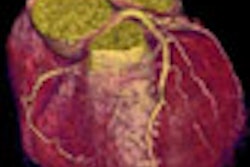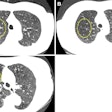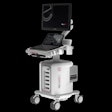Dear AuntMinnie Member,
Young women who undergo coronary CT angiography (CTA) studies are at the highest risk of developing cancer later in their lives -- and the risk is much higher than what's been estimated by official government sources.
That's according to a new study published today in the Journal of the American Medical Association. We're featuring an article by contributing writer Cheryl Hall Harris on the research in our Cardiac Imaging Digital Community.
U.S. researchers used phantoms to measure radiation dose during coronary CTA scans, and extrapolated the risk of developing cancer across different genders and age groups using established computer models. They found that a 20-year-old woman had a 1 in 143 risk of developing cancer during her lifetime from a scan -- more than four times the risk of a man the same age.
Obviously, in the real world very few 20-year-old women receive coronary CTA scans. In addition, the authors found that established CT dose-reduction techniques can reduce the lifetime risk of developing cancer.
But the study does shed new light on the relationship between age, gender, and cancer risk, and suggests that the "one size fits all" model of estimating cancer risk needs revision. Get the rest of the details in the story by clicking here, or visit our Cardiac Imaging Digital Community at cardiac.auntminnie.com.
In other news in medical imaging, we reprise our ongoing examination of digital x-ray conversion with a look at the display monitors that radiologic technologists use for quality control (QC) of computed radiography and digital radiography (CR/DR) studies.
Since QC stations aren't used for diagnostic review, it's often easy to overlook the technical requirements necessary for CR/DR QC monitors. But a new article we're featuring in our Digital X-Ray Community takes the position that DICOM conformance is a necessary feature on any CR/DR QC station.
Find out why by clicking here, or visit our Digital X-Ray Community at xray.auntminnie.com.



















